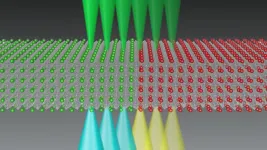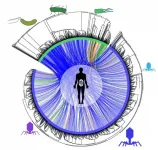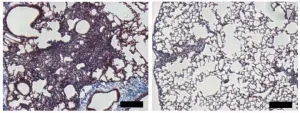(Press-News.org) Recent studies estimate that we use an astounding 129 billion face masks globally every month - that is 3 million a minute. Most of them are disposable face masks made from plastic microfibers.
- With increasing reports on inappropriate disposal of masks, it is urgent to recognize this potential environmental threat and prevent it from becoming the next plastic problem, researchers warn in a comment in the scientific journal Frontiers of Environmental Science & Engineering.
The researchers are Environmental Toxicologist Elvis Genbo Xu from University of Southern Denmark and Professor of Civil and Environmental Engineering Zhiyong Jason Ren from Princeton University.
No guidelines for mask recycling:
Disposable masks are plastic products, that cannot be readily biodegraded but may fragment into smaller plastic particles, namely micro- and nanoplastics that widespread in ecosystems.
The enormous production of disposable masks is on a similar scale as plastic bottles, which is estimated to be 43 billion per month.
However, different from plastic bottles, (of which app. 25 pct. is recycled), there is no official guidance on mask recycle, making it more likely to be disposed of as solid waste, the researchers write.
Greater concern than plastic bags:
If not disposed of for recycling, like other plastic wastes, disposable masks can end up in the environment, freshwater systems, and oceans, where weathering can generate a large number of micro-sized particles (smaller than 5 mm) during a relatively short period (weeks) and further fragment into nanoplastics (smaller than 1 micrometer).
- A newer and bigger concern is that the masks are directly made from microsized plastic fibers (thickness of ~1 to 10 micrometers). When breaking down in the environment, the mask may release more micro-sized plastics, easier and faster than bulk plastics like plastic bags, the researchers write, continuing:
- Such impacts can be worsened by a new-generation mask, nanomasks, which directly use nano-sized plastic fibers (with a diameter smaller than 1 micrometer) and add a new source of nanoplastic pollution.
- The researchers stress that they do not know how masks contribute to the large number of plastic particles detected in the environment - simply because no data on mask degradation in nature exists.
- But we know that, like other plastic debris, disposable masks may also accumulate and release harmful chemical and biological substances, such as bisphenol A, heavy metals, as well as pathogenic micro-organisms. These may pose indirect adverse impacts on plants, animals and humans, says Elvis Genbo Xu.
What can we do?
Elvis Genbo Xu and Zhiyong Jason Ren have the following suggestions for dealing with the problem:
Set up mask-only trash cans for collection and disposal
consider standardization, guidelines, and strict implementation of waste management for mask wastes
replace disposable masks with reusable face masks like cotton masks
consider development of biodegradable disposal masks.
INFORMATION:
Global targets to improve the welfare of people across the planet will have mixed impacts on the world's forests, according to new research.
The United Nations' 17 key areas for global development - known as the Sustainable Development Goals (SDGs) - range from tackling poverty, hunger and sanitation to promoting clean energy, economic growth and reducing inequality.
Many of these goals, such as improved peace and justice, good health and wellbeing, and quality education, will have a positive impact on the Earth's natural forests.
But others, including creating new roads, industry and infrastructure, ...
Nearly 100 percent of the red snapper sampled in the Gulf of Mexico over a six-year period by University of South Florida (USF) marine scientists showed evidence of liver damage, according to a study reported in Aquatic Toxicology.
The study is the first to correlate the concentration of crude oil found in the workhorses of the digestive system -- the liver, gall bladder, and bile - with microscopic indicators of disease, such as inflammation, degenerative lesions, and the presence of parasites. The team sampled nearly 570 fish from 72 Gulf locations between 2011 to 2017 in the wake of the historic 2010 Deepwater Horizon oil spill.
"The results add to the list of other species we've analyzed indicating early warning ...
In a breakthrough for quantum computing, University of Chicago researchers have sent entangled qubit states through a communication cable linking one quantum network node to a second node.
The researchers, based in the Pritzker School of Molecular Engineering (PME) at the University of Chicago, also amplified an entangled state via the same cable first by using the cable to entangle two qubits in each of two nodes, then entangling these qubits further with other qubits in the nodes.
The results, published February 24, 2021 in Nature, could help make quantum computing more feasible and could lay the groundwork for future quantum communication networks.
"Developing methods that ...
"Phase transitions" are a central phenomenon in physical sciences. Despite being technical-sounding, they are actually something we all experience in everyday life: ice melting into liquid water, or hot water evaporating as steam. Solid, liquid, and gas are three well known "phases" and, when one turns into another, that is a phase transition.
Rare-earth nickelate oxides, also called nickelates, have attracted a lot of interest from researchers because they display an electronic phase transition, which may be exploited in future electronic devices. This particular phase transition consists of turning from a metallic ...
Game theory is known to be a useful tool in the study of Machine Learning (ML) and Artificial Intelligence (AI) Multi-Agent interactions.
One basic component of these ML and AI systems is the exploration-exploitation trade-off, a fundamental dilemma between taking a risk with new actions in the quest for more information about the environment (exploration) and repeatedly selecting actions that result in the current maximum reward or (exploitation).
However, the outcome of the exploration-exploitation process is often unpredictable in practice and ...
The balance of human intestinal microbiota, consisting of hundreds of bacterial species and phages (bacteria viruses), is crucial to good health. A research team, including scientists from the CNRS* and the Institut Pasteur, has characterised the phage-bacterial interaction networks of the microbiota in ten healthy individuals, with unprecedented precision. Scientists detected several hundred bacterial and phage genomes and identified the thousands of interactions that bind them by quantifying the contacts between the DNA molecules of viruses and their hosts. This method has the advantage ...
Researchers have published a study revealing their successful approach to designing much quieter propellers.
The Australian research team used machine learning to design their propellers, then 3D printed several of the most promising prototypes for experimental acoustic testing at the Commonwealth Scientific and Industrial Research Organisation's specialised 'echo-free' chamber.
Results now published in Aerospace Research Central show the prototypes made around 15dB less noise than commercially available propellers, validating the team's design methodology.
RMIT University aerospace engineer and lead researcher Dr Abdulghani Mohamed said the impressive results were enabled by two key innovations - the numerical algorithms ...
Researchers at the University of Alabama at Birmingham have identified a new molecular target that could potentially treat the deadly, aging-related lung disease idiopathic pulmonary fibrosis (IPF). The study, which will be published March 10 in the Journal of Experimental Medicine (JEM), suggests that targeting a protein called MDM4 could prevent respiratory failure by initiating a genetic program that removes scar tissue from the lungs.
IPF is characterized by the accumulation of scar tissue that stiffens the lungs and makes it difficult for patients to breathe and get sufficient oxygen into their blood. Though the causes of IPF remain unclear, age is a significant risk factor: the disease is ...
Blood pressure measurements in children and adolescents should be taken from both arms after new research showed substantial differences could be seen depending on which arm was used.
The study, led by the Murdoch Children's Research Institute (MCRI) and published in the Journal of Hypertension, found even a small difference in blood pressure measurements between arms could lead to a wrong diagnosis.
MCRI PhD candidate and study lead author Melanie Clarke said this was the first study worldwide to determine the size and frequency of inter-arm blood pressure differences in children and adolescents.
The study involved ...
A researcher at the Instituto de Astrofísica de Canarias (IAC) is the lead author of a study with proposals for "technosignatures" -evidence for the use of technology or industrial activity in other parts of the Universe- for future NASA missions. The article, published in the specialized journal Acta Astronautica, contains the initial conclusions of a meeting of experts in the search for intelligent extraterrestrial life, sponsored by the space agency to gather advice about this topic.
In the article, several ideas are presented to search for technosignatures that would indicate the existence of extraterrestrial civilizations, ...








